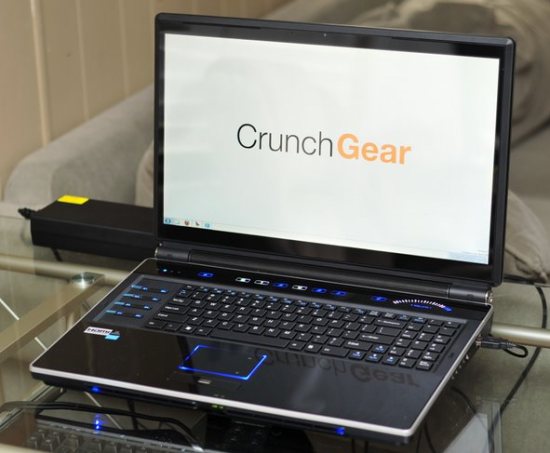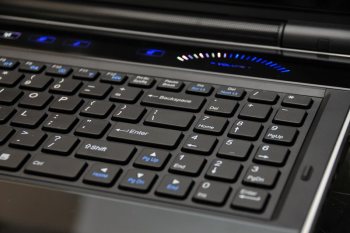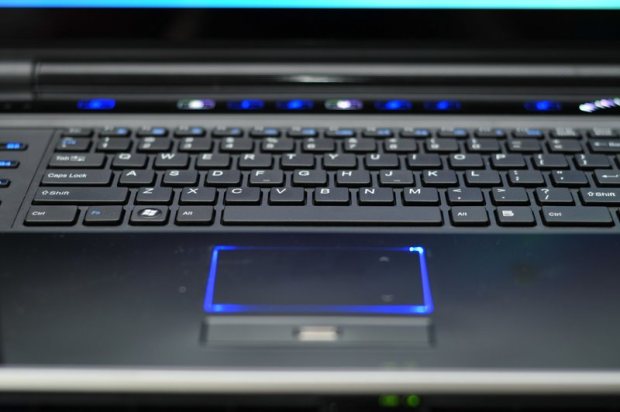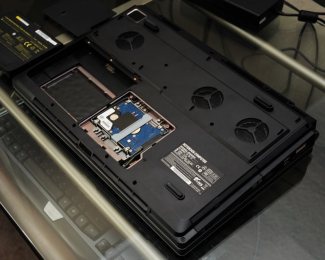 Short Version: The Deimos is the latest addition to BFG’s new line of computers. Intended as specialist gaming machine, the Deimos is big, beautiful, and very fast. Heat, bulk, and short battery life are to be expected from a gaming laptop, and aside from those it provides an excellent experience.
Short Version: The Deimos is the latest addition to BFG’s new line of computers. Intended as specialist gaming machine, the Deimos is big, beautiful, and very fast. Heat, bulk, and short battery life are to be expected from a gaming laptop, and aside from those it provides an excellent experience.
Pros:
- Fast
- Surprisingly light weight
- nicely designed and set up
Cons:
- Short battery life
- Large size
- Runs hot
Price as reviewed: $4,423
While BFG is new to selling complete computer systems, they aren’t new to high performance gaming. BFG has been producing performance PC hardware for many years, and just this year got into building their own systems. The Deimos was launched at the end of October, and is intended to compete with other gaming laptop lines, such as Alienware’s M17x.
Does it compete? In a word, yes. In some ways, the Deimos surpasses the M17x. For example, when I reviewed the M17x, I had some issues with the biometric security system. Using your laptop’s webcam as a security device is a clever concept — if only it worked consistently. On the Deimos, however, everything worked perfectly out of the box. Performance is comparable. Battery life is about the same. What’s gone is the obvious “I spent $4500 on this computer!” factor that you get with the little alien head on the lid.
Let’s get down to it. Here are the specs on the system I reviewed:
Monitor: 18.4 inch, 1920×1080 resolution
Processor: Intel Core 2 Extreme QX9300 2.53GHz
Memory: 2x 4GB PC3 8500 (1066 MHz) DDR3 (8GB total)
Graphics: 2x GeForce GTX 280M 1GB (SLI)
Optical Drive: Dual Layer Blu-Ray Disc Reader (BD-ROM, DVD/RW, CD-RW)
HDD 1: Seagate Momentus 500GB 7200 RPM SATA II
HDD 2: Seagate Momentus 500GB 7200 RPM SATA II
LAN: Realtek RTL-WLAN 802.11 b/g
Bluetooth: Internal Bluetooth v2.1
Sound: Realtek ALC883 8-Channel Azalia HD Audio
Video Camera: Bison built-in USB 2 MP Camera
Operating System: Microsoft Windows 7 Home Premium – 64-bit Edition
Performance: As you can expect from this configuration, the machine is fast. I ran some benchmarks using Far Cry 2, which averaged a framerate of 54.26 at 1920×1080, Direct3D 10, and Overall Quality set to “Ultra High.” 3DMark Vantage reported 11,799, which is a very close comparison to the M17x at 11,904. Of course, if you’ve read my reviews before, you’ll know I’m not huge on reporting numbers; I prefer to talk about the feel of the system. And basically, the Deimos is a great computer. I’m very much into the gaming, and that’s what’s important to me when I’m using a system. The Deimos is fast, plays games really really well (42 FPS in Dalaran, settings maxed, for you World of Warcraft people) and is surprisingly light for the amount of hardware that’s jammed in there. The system has DVI and HDMI out, and a total of four USB ports (two on the left, two on the right). The back is reserved for cooling vents and the power cord. One thing to be aware of: don’t expect to be able to overclock this machine using the BIOS. The BIOS on this system is functional, yet bare bones. There are no options for overclocking at all.
 Controls: The keyboard took some getting used to; the keys aren’t exactly a style that I’d normally prefer, coming from the netbook school rather then a standard keyboard. And the numeric keypad is a hot mess. It’s pretty much impossible to touch type using the number pad because everything is jammed together with the arrow keys and the standard keyboard. There’s more then enough room that they could have provided a little space between the two and made it a bit more user-friendly. There is also a series of “G-keys” down the left side. These are customizable macro keys are much like what is used on the Logitech G-Series keyboards. These too, work as intended, however they do take up quite a bit of real estate on the left side of the keyboard area.
Controls: The keyboard took some getting used to; the keys aren’t exactly a style that I’d normally prefer, coming from the netbook school rather then a standard keyboard. And the numeric keypad is a hot mess. It’s pretty much impossible to touch type using the number pad because everything is jammed together with the arrow keys and the standard keyboard. There’s more then enough room that they could have provided a little space between the two and made it a bit more user-friendly. There is also a series of “G-keys” down the left side. These are customizable macro keys are much like what is used on the Logitech G-Series keyboards. These too, work as intended, however they do take up quite a bit of real estate on the left side of the keyboard area.
The trackpad (centered, and highlighted with LED light) works as expected, with no major issues. The left and right button (there’s only one, and you click on either side) responds well, and doesn’t feel mushy or too stiff. There is a fingerprint reader centered in the button, which provides biometric login options.

Appearance: Aesthetically, it’s a little bright. Where it’s nowhere near as gaudy as an Alienware system, it does have a touch sensitive strip across the top, and all the icons are lit from beneath with LEDs.The touch activated icons turn on the webcam, Wi-Fi, or Bluetooth hardware. You can also control the volume, or activate your web browser or media player. The LEDs in the case (shining out the front and back) and the lid can change color, however the process is less than intuitive. The case is also extremely shiny, and regrettably shows fingerprints incredibly well. BFG is aware of this, even to the point of including a large microfiber cloth for wiping it down. Overall, compared to the Alienware, the Deimos is almost tasteful.
 It is interesting to note that the Deimos is a re-branded Sager notebook. Further research showed that were you to go online and order a system with the same configuration, you’d save yourself $100. Despite this fact, I’d still purchase this computer from BFG, due to their excellent record on customer service. From a value standpoint, compared to the Alienware M17x, I’d still choose the BFG Deimos. For around the same price (the M17x, configured the same costs $4,399, $24 less), the Alienware laptop has a smaller screen, weighs twice as much, and a profile that screams “steal me!”. That’s not to say the Deimos is the ideal commuter laptop — it is quite large. But it lacks the ostentatious nature of the M17x.
It is interesting to note that the Deimos is a re-branded Sager notebook. Further research showed that were you to go online and order a system with the same configuration, you’d save yourself $100. Despite this fact, I’d still purchase this computer from BFG, due to their excellent record on customer service. From a value standpoint, compared to the Alienware M17x, I’d still choose the BFG Deimos. For around the same price (the M17x, configured the same costs $4,399, $24 less), the Alienware laptop has a smaller screen, weighs twice as much, and a profile that screams “steal me!”. That’s not to say the Deimos is the ideal commuter laptop — it is quite large. But it lacks the ostentatious nature of the M17x.
Final thoughts: I wholeheartedly recommend the BFG Deimos. It’s a fine machine, and doesn’t try to be more then that. I’ve found it to be more then sufficient as a desktop replacement, both for work and play. Yes, the price is high, but if you are buying a performance laptop, you have the budget for it and you probably don’t really care about how much it costs; you want the best. I will admit that I’m not a huge fan of the keyboard, but it was a simple thing to plug an external keyboard in when I was sitting at my desk. The keyboard was just fine for casual use, but perhaps it’s not for the business user.